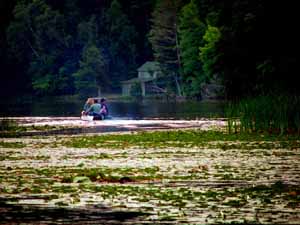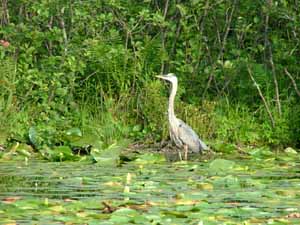THE TOP TEN LAKE PROTECTION LIST
Delivered to the Northwest Lake Leadership Conference, 2004
Jim Brakken, Wisconsin Association of Lakes President
 Like many of you, I have run across many bits of information related to lake protection over the past decade. Here are ten of those information bits that I think should be offered to everyone who shares our enjoyment and concern for Wisconsin’s lakes.
Like many of you, I have run across many bits of information related to lake protection over the past decade. Here are ten of those information bits that I think should be offered to everyone who shares our enjoyment and concern for Wisconsin’s lakes.
First, without going into detail: Buffer zones do work.
The research now clearly shows that runoff from lawns and impervious surfaces washes phosphorus and other nutrients into our lakes. A thirty foot buffer zone filters out much, sometimes most of the excess nutrients. A forty food buffer is better yet.
Second, the stirring effect from aggressive boating near shore and in shallow areas of lakes makes nutrients more available for plant growth. So does the removal of naturally occurring aquatic plants. Aquatic plants: very good. High speed boating near shore: bad, very, very bad.
Number 3: Although all fertilizers contribute to the problem, phosphorus is the worst fertilizer when it comes to our lakes. One pound of phosphorus can yield 500 pounds of algae. Dane County recently banned all phosphorous from fertilizers used in the county. The entire state should follow suit. (After two years, Minnesota has had no problems with this law.)
Number 4: Old and poorly maintained septic systems can have devastating effect on a lake, many times worse than any fertilized lawn. All septic systems should be serviced and inspected regularly. This should be required by every Wisconsin county in accordance with the State mandate. All counties should comply with the law.
Now we all know that adding nutrients will increase algae growth and diminish the clarity of the water. At worst this can result in algae blooms capable of changing a beautiful lake into a disgusting, odorous, fish-killing, scum-covered body of pea soup. At best, it will cause your lake to be less clear.
This brings me to number 5: Protecting your lake is protecting your property value. Studies in Wisconsin, Minnesota and elsewhere show that a one foot change in water clarity can cause a 7% change in the value of your lakeshore property. On a $200,000 lake property, a one foot change in water clarity can cause you or me to gain or lose $14,000 in resale value. Restoring your lake front will protect your lake and your investment. Based on research done last summer, improving the clarity of all lakes in Sawyer County by just one foot would result in a total gain of almost one trillion dollars. That’s trillion with twelve zeros! There is a lake association near La Crosse that improved their water clarity by over ten feet. That translates into a property value increase over $100,000 per owner!
Number 6: A healthy lake is more resistant to invasion by exotic aquatic plants and other invasive species. Eurasian water milfoil is, in my opinion, the single greatest threat to our northern lakes. Every landing should have large signs warning boaters to clean their boats and trailers properly and we should be training every boater about the urgent need to stop the spread of EWM.
Number 7: Our northern Wisconsin economy is driven by tourism. And tourism is dependent upon clean, safe healthy lakes. Whether local, state, county or federal, our political leaders all know that Wisconsin’s lakes are extremely important on many levels. They will help us. Our job is to communicate with them and let them know we want to work with them. They need our input. We need to be the squeaky wheel.
After decades on and around the water, I have never heard anyone say they want to do anything to harm our lakes. And yet, virtually every problem our lakes face today is caused by people.
That’s number 8: The cumulative impact of actions by people with good intentions continues to be at the root of the challenges facing our lakes today. Some call it Death by a thousand cuts.
No doubt by now that you have heard of the Wisconsin Lakes Partnership. The partnership is unique to Wisconsin. It is one reason why many other states look to Wisconsin for leadership in statewide lake management. This strong partnership includes our Wisconsin DNR, UWEX and your Wisconsin Association of Lakes. Now the DNR does a great job with research, resource management, enforcement and many other tasks. But we have 15k lakes and an estimated 5 million residents and visitors who use them. The DNR cannot do it all. Research and education outreach by the University of Wisconsin is a great help to our lakes and lake users. Wisconsin is known throughout the northern hemisphere for the surface water education materials we produce. But, like the DNR, Extension cannot do it all. Not only do these agencies lack the staff and funding to adequately serve all our lakes, these two partners are restricted by law from legislative lobbying. But the third partner, a citizens group known as the Wisconsin Association of Lakes fills that gap with our strong, effective lobbying efforts.
 The Wisconsin Association of Lakes is a nonprofit group of citizens, organizations, and businesses working for clean, safe, healthy lakes for everyone.
The Wisconsin Association of Lakes is a nonprofit group of citizens, organizations, and businesses working for clean, safe, healthy lakes for everyone.
It has become clear to me that, if we want to protect and preserve our lakes, it is the people who value our lakes that must rise to the task. We will have help from the DNR and University of Wisconsin Extension, but the bottom line is that it is up to us. We all have to pitch in.
There are many ways for us to participate:
– Setting a good example, then encouraging others to restore their waterfront by creating buffer zones is a good start.
– Sending new volunteers to conferences like the NWLC and the Lakes Convention is another.
– Encouraging your neighboring lake to form an association and to join WAL will also help.
– Making a contribution to the Wisconsin Association of Lakes’ legal action fund will help us fight for our lakes in court. That’s number 9, by the way. WAL needs a healthy legal action fund if we expect to be prepared to defend our lakes. . . and your lake. . . in the courts.
Here are more way’s to help our lakes:
– Again, encourage people to restore their shoreland and create buffer zones. Lead by example! Put away the mower. Take back your free time!
– Respond to Wisconsin Association of Lakes’ action alerts and speak on behalf of our lakes at public information sessions.
 – Upgrade to a four stroke outboard.
– Upgrade to a four stroke outboard.
– And how about joining the Wisconsin Association of Lakes Individual Membership category to help guide the Wisconsin Association of Lakes?
– Taking good care of your own shoreland and training your grandchildren to do the same is important. Teach them how to listen to the lake.
– And we must follow our zoning regulations both in letter and in spirit. The same goes for all fish and game regulations.
– And how about making a contribution to the Wisconsin Association of Lakes youth fund? Why are we working so hard to protect our lakes today if we aren’t willing to prepare youngsters to care for our lakes tomorrow?
This is only the beginning of the list. There are many steps we can take and when it comes to protecting Wisconsin’s lakes. There are no second chances. Once the resource is gone, it’s gone for good. But with strong support from DNR and UWEX Lakes, the citizens who value our lakes and lakeshores will determine the future of our lakes.
This brings us to the tenth and final bit of information to share with others: It’s up to you. Not the government, not your neighbors . . . You! You have to spread the word, share some leadership and inspire others to take small steps to save our waters. By protecting our lakes not only will you protect your property values but you will also assure that all future visitors will enjoy clean, safe healthy northern Wisconsin lakes. Can it be done? For the answer, I turn to the anthropologist Margaret Mead who said:
“Never doubt that the work of a small group of thoughtful, committed citizens can change the world. Indeed, it’s the only thing that ever has.”
—Margaret Mead (1901-1978)
For more information, contact the Wisconsin Association of Lakes at www.wisconsinlakes.org or 800-542 LAKE.